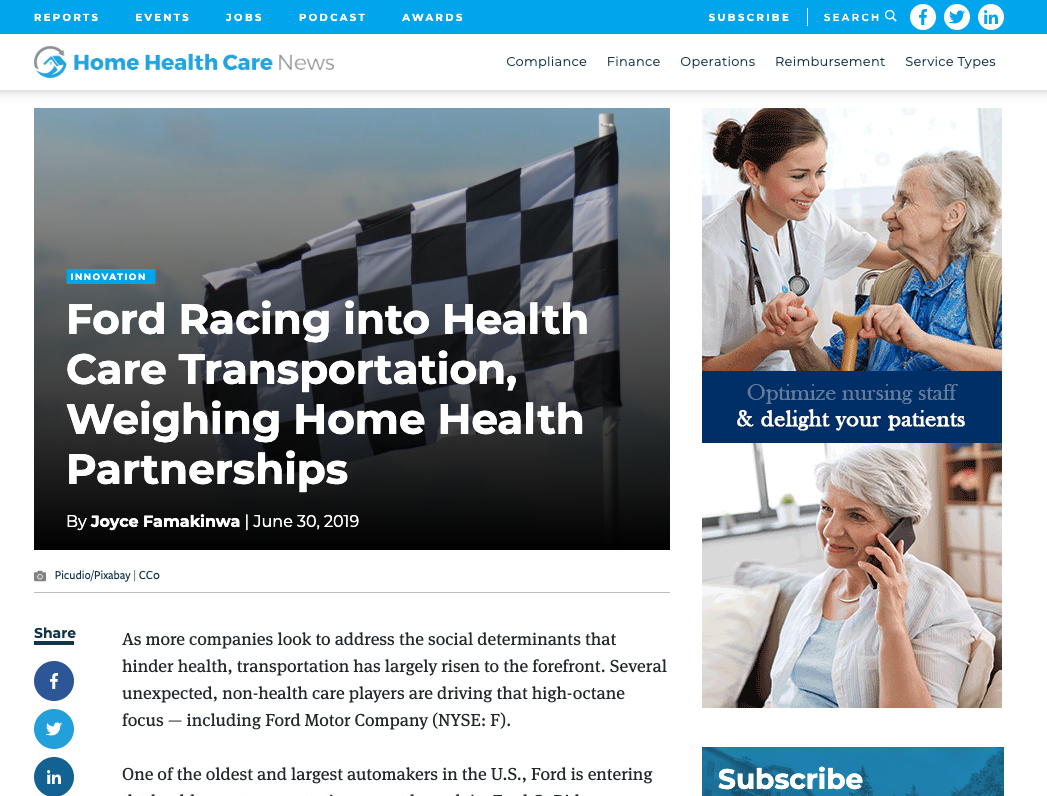Veyo Featured in Healthcare Dive
July 2, 2019
Veyo was recently mentioned in a Healthcare Dive article about NEMT and healthcare transportation. The original article, “Could NEMT’s pivot to the commercial sector be a wrong turn?,” can be found here.
——-
Employers and commercial plans are increasingly looking to partner with players like Uber and Lyft for non-emergency medical transportation, raising questions about the ROI in a healthier population.
In recent weeks, Uber has ratcheted up its commercial ties in the non-emergency medical transportation market, giving transportation companies and analysts alike pause.
The ride-hailing giant announced three partnerships in the healthcare industry in just seven days, linking with care coordination company Carisk, health coaching platform Pack Health, and venture capital-backed health tech start-up Grand Rounds between June 13 and June 19.
CMS kick-started a flurry of activity in NEMT in April last year when it introduced a rule giving privately run Medicare Advantage plans the option to offer non-medical benefits such as transportation, causing nontraditional players like Uber and Lyft to ramp up their interest in the space.
Uber’s pivot toward the commercial sector comes on top of its current business with Medicare Advantage and Medicaid, the two traditional payers for NEMT. But experts warn large, self-insured employers and payers offering NEMT to their beneficiaries might not see as high a return on investment as they expect. Making NEMT an expectation in healthcare could also raise costs for the commercially insured population in return for the smaller payback.
“The expansion of the NEMT concept from a support for low-income beneficiaries with transportation challenges to commercially insured beneficiaries who may just find it inconvenient to get to their medical appointment — that raises concerns for return on investment,” Michael Abrams, managing partner of healthcare consultancy Numerof & Associates, told Healthcare Dive.
Unproven ROI
Employers and private insurers are becoming interested in transportation as a method to curb costs from missed medical appointments. Uber and Lyft have partnered with hundreds of hospitals, payers, transportation brokers and other companies to streamline the process and put a familiar face on what is, for many, a novel service.
Uber Health alone has more than 1,000 partnerships and is growing rapidly, head of Uber Health Dan Trigub told Healthcare Dive, although the company doesn’t share more specific numbers publicly.
NEMT began in 1966 with the inception of Medicaid and the requirement that state programs had to provide necessary transportation for beneficiaries to and from providers. The benefit was initially just for low-income beneficiaries without a reliable, inexpensive way to get to their healthcare appointments, along with people with disabilities and people with limited public transportation options or long travel times like those in rural areas.
Adults who lack transportation to medical care are much more likely to have chronic conditions that can escalate to needing emergency care if not properly managed. They’re also more likely to be poor, elderly, disabled or have multiple health conditions.
“This is most pronounced in lower income populations where transportation is a challenge, or for those living with chronic conditions,” Josh Komenda, president of NEMT broker Veyo, told Healthcare Dive. “Someone in an employer-based plan typically doesn’t have as much difficulty accessing transportation.”
Medicaid enrollees alone are 10 times more likely to have their access to primary care hindered by transportation issues than those with private insurance, according to an Annals of Emergency Medicine study.
But Uber Health’s head argued that NEMT could be a useful benefit for a healthier or higher-income population — in some cases.
“We’re not suggesting that every single employee or every single person should have transportation covered for them by their payer,” Trigub said. “It has to be done smart and it has to be done where there is ROI.”
Employers remain interested
Uber and its partners remain bullish on the benefits of NEMT in the commercial space, believing the same general logic applies in the commercial sector as it does in Medicaid and MA.
“We can have outsized impact in those vulnerable populations, but we absolutely think this could work with commercial payers and others,” Trigub said.
Non-emergency medical transportation is a $3 billion market alone, but that’s small potatoes compared to the larger medical transport market (including emergency and medical product transportation) that some researchers expect will be worth $42 billion in the next five years.
Generally, payers and providers contract with transportation brokers or marketplaces like Veyo, Roundtrip or Boston-based Circulation. From there, case managers, caregivers, social workers or others on the healthcare side can request rides for their patients from a variety of transportation companies, whether it’s a full-service van with a certified driver or a simple rideshare.
Uber, which saw $50 billion in bookings in 2018 yet failed to turn a profit, is looking toward the lucrative healthcare market to spur revenue growth, experts say.
Both Uber and Lyft had disappointing IPOs following months of hype, with Lyft ending its first trading day only 8% higher than its initial trading price and Uber shares trading 7% lower on day one. Uber has recovered somewhat since its debut, now trading slightly over its IPO price of $45 a share.
The San Francisco-based ride-hailing giant formed the separate HIPAA-compliant division Uber Health in March 2018, taking advantage of its name brand and past experience in the space to gain market share. Its platform allows healthcare workers to book a ride on demand or schedule one in advance for a patient. The passenger is then alerted via text or phone call.
Grand Rounds, which works with employers to provide guidance on employees’ medical records, partnered with Uber in mid-June. The San Francisco-based company manages more than 100 companies, including Comcast, Walmart and News Corp, all of which are self-insured and cover more than 4.7 million patients.
“Employers know how important it is to keep their employees and their families healthy; this is not only good for business, but it’s the right thing to do for their people,” Nupur Srivastava, vice president of product for Grand Rounds, told Healthcare Dive via email. Grand Rounds plans to evaluate savings over time as the Uber rollout continues.
And employers have been reaching out to Uber about NEMT for a while now, Trigub said, noting there’s “been a lot of interest to work with us to help them better serve their employees when it comes to delivery of care.”
Further obstacles
Uber does sell some services tailored toward a more needy population: Uber WAV, a network of wheelchair-accessible vehicles currently being pilot tested in 16 markets worldwide; and uberASSIST, a traditional ride-hailing service with certified drivers for riders who need additional help, like seniors, pregnant women or those with disabilities.
But transportation brokers and providers note Uber and Lyft face significant obstacles if they ever want to expand their offerings within NEMT, including investment in driver training, specialization of vehicles and services, and thorny regulations that change state-by-state.
About 80% of the Medicaid population can move themselves without assistance, according to some estimates. However, out of that 80%, there’s a large segment that still needs extra help from drivers, whether it’s assistance to and from their door and into their car or a caregiver to watch them in transit due to behavioral health needs.
“When you boil it down, many people can get in front of a building and get into a ride share,” Mark Switaj, founder and CEO of transport marketplace Roundtrip, told Healthcare Dive. “But many people can’t.”
Traditional ride-hailing companies wanting to expand to meet the requirements of a higher-need population would run into a host of issues, including picking up someone with autism or behavioral health needs, making sure the car is clean of drugs or alcohol if transporting someone to rehab, or training in what to do if a pickup has a fainting spell following dialysis, for example.
“Specialty providers who have the equipment and have trained their staff to deal with the special needs of disabled adults and others would certainly have an advantage relative to Uber or Lyft,” Abrams noted. “One size fits all is rarely a great strategy for winning the market.”
Usually, large payers will hire a transportation broker to contract with different types of local transportation providers, negotiate the rates, credential the providers and make sure they’re up to date with regulations and inspections, manage the reservation centers and take requests from members, among other things.
Uber Health’s HIPAA-compliant dashboard does allow healthcare companies to request multiple rides simultaneously, schedule rides in advance, manage requested rides, view ride history and manage billing. Yet transportation brokers remain skeptical it will ever be able to manage the breadth of organizational tasks more expansive healthcare transportation requires.
“We have that full capability,” Veyo’s Komenda said. “Uber and Lyft don’t.”
Want to learn more about Veyo?
Share a few pieces of contact information with us and we’ll send you our Introduction to Veyo doc.




